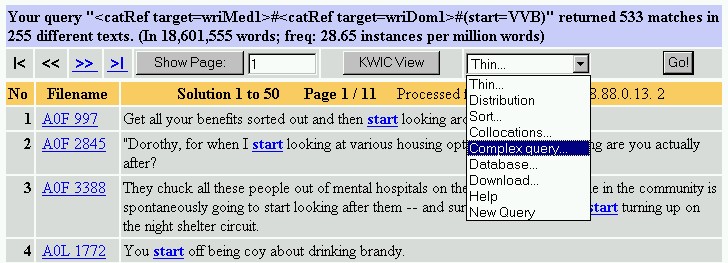Looking at Distribution
First weíll look at start + to-infinitive in fiction, then in non-fiction; then do
the same for begin.
Before you start, follow this
link and make a copy of the table - either print it out or copy-and-paste it over to a word processor. Then you
can use it to keep a note of your results.
Now log on to BNCweb.

- Letís start with written texts. You can limit your search to these texts by clicking on "Written texts"
(instead of "Quick query" which we used previously).
- In the boxes on the right, click on (Medium of text) [ ] Book, and (Text type) [ ] Imaginative.
- Look for start as a base verb: start=VVB
- Write down in the table:
- the frequency
- the frequency per million words
- the total number of words
- In the box marked "Thin...", click and go down to "Complex query". Click "Go".

When the next page loads, press "Submit".
- You should reach a fresh window with several columns. Each one represents a word position in relation to start
(which is called the node word; this just means the "search word"). In the box for the word to the right of
start, position +1, find the tag for the infinitive marker. Itís TO0, and submit.
- You now have a concordance for start to in fiction texts. Note down the frequency, and frequency per million
words in the table.
- Repeat steps (1-7) for non-fiction texts - that is, all the other Text Types put together.
- Do the same steps (1-8) for begin to. If you have time, you should also look at start -ing (i.e.
start followed by any verb in the ing-form) in fiction and non-fiction.
What can you say about the distribution of each verb?
Does this fit in with what you expected?
|



 WordSmith
WordSmith BNCweb
BNCweb Intro to BNCweb
Intro to BNCweb More on BNCweb
More on BNCweb Refining BNCweb Queries
Refining BNCweb Queries DIY Corpora
DIY Corpora



